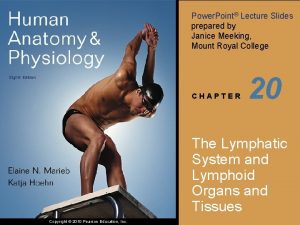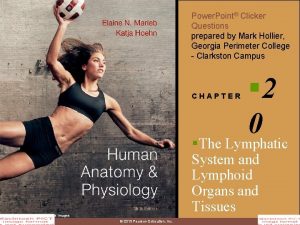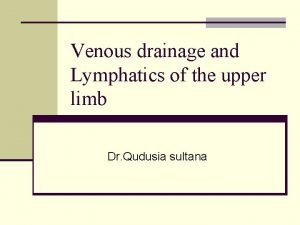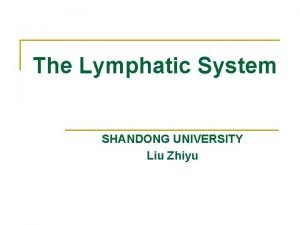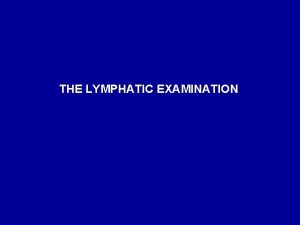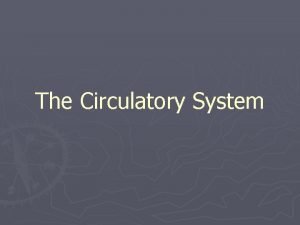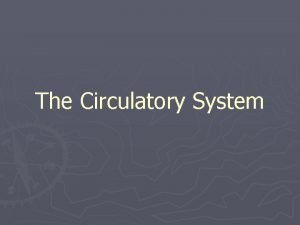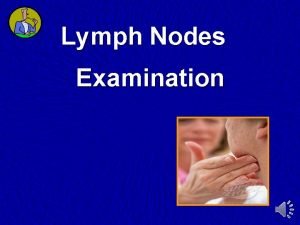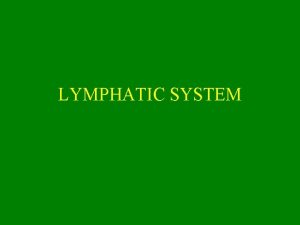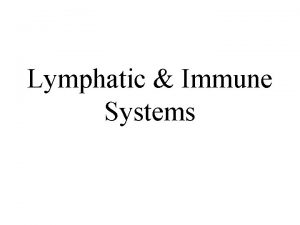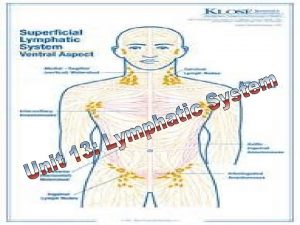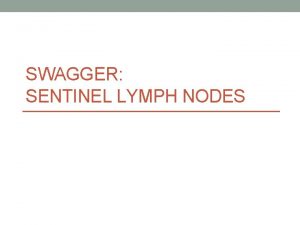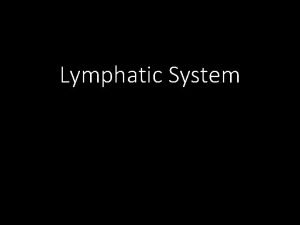Lymph nodes examination of food animals The Lymphatic









- Slides: 9

Lymph nodes examination of food animals

The Lymphatic System § Lymph is a medium: üSupply oxygen & nutritive matter are transferred from the blood to the body tissues üThe means by which waste products from these tissues are removed üThe presence of lymph around the tissue cells is maintained by a slow exudation of this fluid through the capillary walls & in to the surrounding tissue §Afferent lymphatics: Vessels conveying lymph to a lymph node §Efferent lymphatics: Discharge eventually in to larger lymph collecting vessels, the direction of the lymph flow in every case being towards the heart §Largest lymph collecting vessel is the thoracic duct §Lymph from posterior part of the body: lumbar & intestinal to thoracic duct & open in to the anterior venacava §Lymph from anterior part of the body: To tracheal lymph & towards jugular vein

Lymph node: Introduction ØRound masses of lymphoid tissue ØSurrounded by a capsule of connective tissue ØFound along the course of lymphatics ØConsists of a reticulum of connective tissue fibers in the meshes of which are contained numerous small rounded cells-the lymphocytes

Lymph node: Introduction ØThe color of lymph nodes is variable: (white to greyish blue or almost black) § In ox: mesenteric LN of ox black in color § In Pigs: LN are lobulated & almost white (exception: LN of head and neck which are reddish in color) ØConsistency of LN: consistency is firm rather than soft § Generally oval in shape & somewhat compressed ØSize: varies from pin head size to 10 -20 cm or even more § In the horses: LN are small & grape like clusters § Larger in young animals than in the adults

Parts/Organ Lymph node Disease condition Head Parotid, submaxillary, retropharyngeal FMD, stomatitis, rinderpest, actinomycosis, actinobacillosis, cysticercosis Lungs Bronchial, Mediastinal Pleurisy, pneumonia, tuberculosis Heart Mediastinal Traumatic/tubercular, pericarditis, peticheal haemorrhages on the epicardium and endocardium, cysticercosis, hydatidosis, flabbiness of heart Liver Portal & hepatic Fatty changes, actinobacillosis, abscess, cirrhosis, hydatid cysts, fascioliasis Oesophagus, stomach, intestine Gastric & mesenteric The serous surface for tuberculosis, actinobacillosis, penetration by any foreign body Kidney Renal Spleen Splenic Tuberculosis, anthrax, infracts, haemorrhages, Uterus Iliac & renal septic metritis, evidence of recent parturition or pregnancy Udder Supramammary Abscess, septic metritis, tuberculosis Testes Superficial inguinal Orchitis Carcass Prescapular, popliteal, renal, cervical, intercostal, xyphoid or sternal auxillary, prepectoral, external, internal iliac Bruises, injuries, abdominal & thoracic cavities for tuberculosis, poorness, emaciation & state of nutrition

Haemal lymph node § Deep red or almost black in color § Oval in shape § Pea size § Absent afferent and efferent lymphatics § Accessory spleen: RBCs disintegration § Numerous in Sheep and OX § Absent in: Horse & Pigs § Cattle: along the course of aorta and Subcutaneous fat § Sheep: Beneath the peritoneum in sub-lumbar region § Being larger and more numerous in animals suffering from anemia &cachectic conditions v. Lymph nodes absent in poultry

Lungs Lymph nodes Bronchial (tracheobronchial) and mediastinal: Incise Lung inspection - Bronchial left (No. 1) and right (No. 2) and mediastinal (No. 3) lymph nodes are viewed and incised Manual on meat inspection for developing countries

Liver v. View and palpate entire surface(both sides) v. View the gall bladder. For cattle over 6 weeks of age, incise as deemed appropriate to detect liver flukes. Open large bile ducts v. For sheep, pigs and game, incise as deemed appropriate for parasite v. Lymph nodes Portal (hepatic) Liver inspection - Incised portal (hepatic) lymph nodes (No. 1) and opened large bile duct (No. 2). Manual on meat inspection for developing countries

Rumen, reticulum, omasum and abomasum § Viewing and incision of the mesenteric lymph nodes. § In this case an incision was performed to demonstrate the mesenteric lymph nodes chain. Manual on meat inspection for developing countries
 Lymph tends to stall inside lymph nodes. this is due to:
Lymph tends to stall inside lymph nodes. this is due to: Lymph tends to stall inside lymph nodes
Lymph tends to stall inside lymph nodes Dorsal venous network
Dorsal venous network Infraclavicular node
Infraclavicular node O que é punção capilar
O que é punção capilar Lymph drainage of uterus
Lymph drainage of uterus Axillary lymph nodes drainage
Axillary lymph nodes drainage Lymph nodes in forearm
Lymph nodes in forearm Lymph nodes: “filters of the blood”
Lymph nodes: “filters of the blood” Lymph nodes: “filters of the blood”
Lymph nodes: “filters of the blood”
